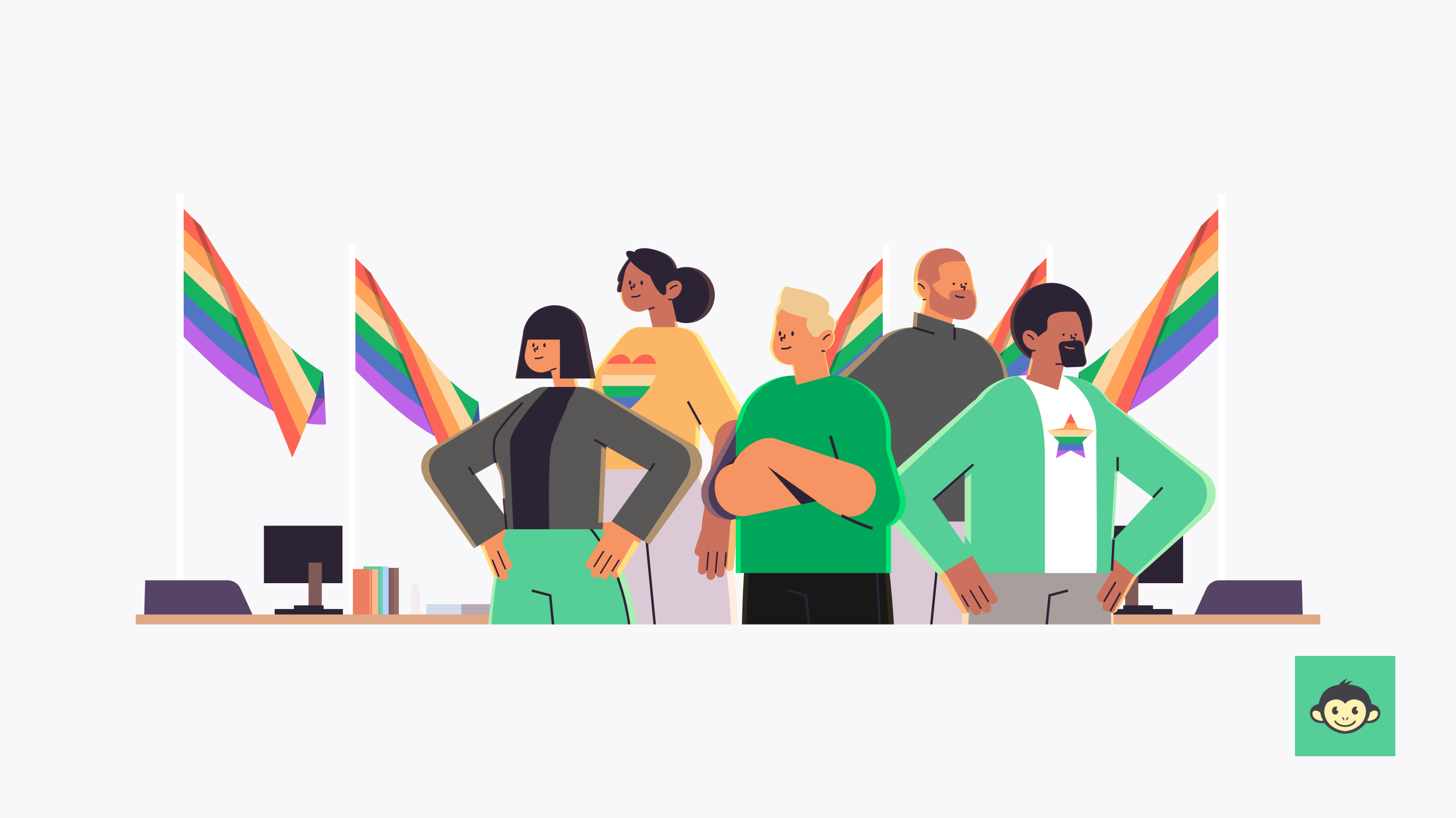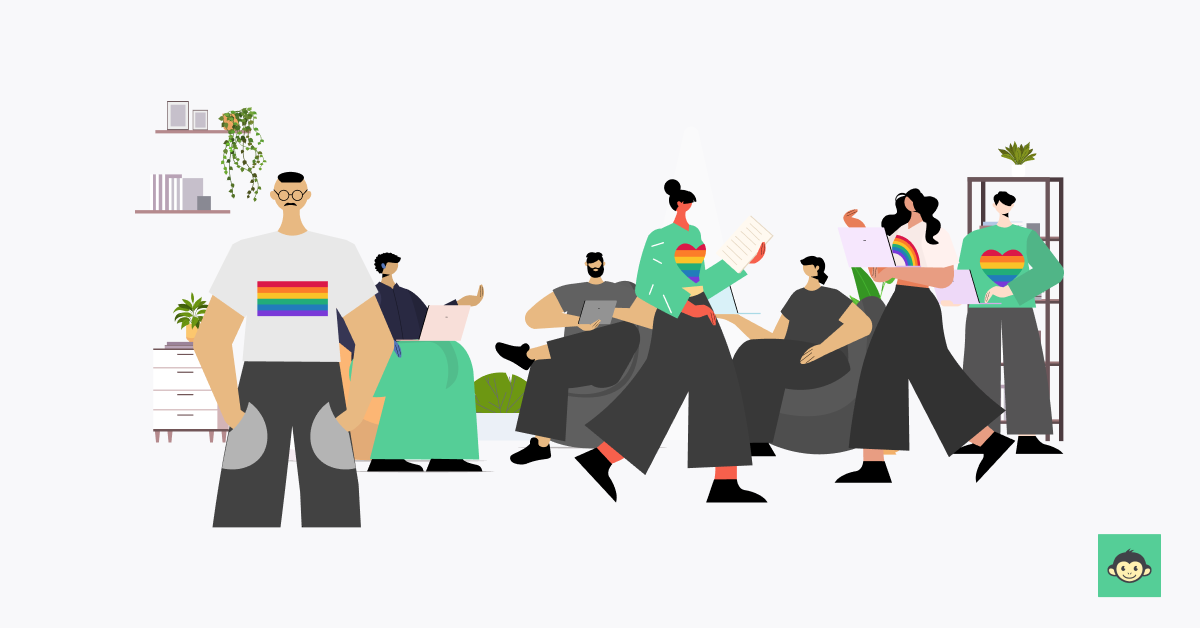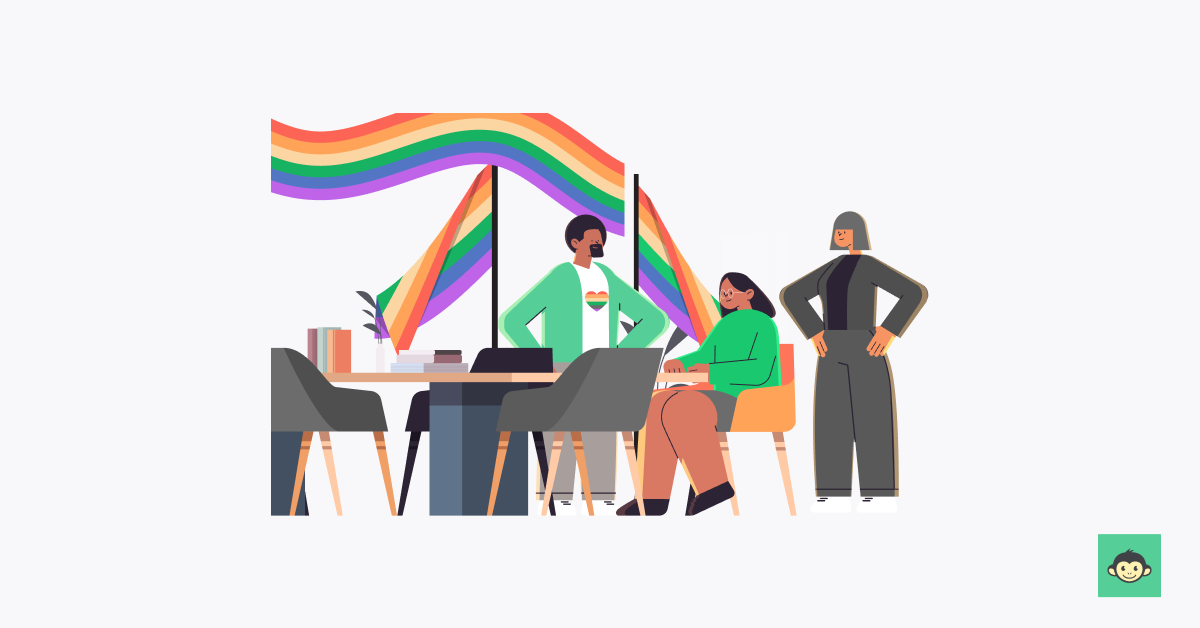What is rainbow washing: Definition and negative effects to look out for in 2024

June may be Pride Month, a time painted in vibrant rainbows and overflowing with celebrations for the LGBTQ+ community. But amongst the parades and festivities, there lurks a deceptive practice: rainbow washing.
This isn't a new phenomenon. Just like "greenwashing" uses environmental concerns for profit, corporate rainbow washing uses the rainbow flag and LGBTQ+ symbols to bolster a company's image without meaningful action or support. While rainbow colors splash across logos and merchandise, the reality behind them might be far from inclusive.
But don't be fooled by the dazzling visuals! This seemingly harmless trend can have real consequences for the LGBTQ+ community. Let's unpack the harmful effects of rainbow washing and equip ourselves to identify and reject it.
Rainbow washing at work definition

Rainbow washing at work, also known as corporate rainbow washing, is a term used to describe the phenomenon where companies or organizations superficially express support for the LGBTQ+ community, often during June or other significant events, without genuinely addressing the needs or concerns of LGBTQ+ individuals.
It involves the use of rainbow imagery, pride parades, flags, and supportive messaging as a marketing strategy to enhance the company's image or profit margins, rather than demonstrating authentic allyship or advocacy for LGBTQ+ rights.
In essence, rainbow washing at work creates a false sense of support for the LGBTQ+ community while neglecting to implement meaningful initiatives or policies that promote inclusivity and equality within the workplace. This practice can be harmful as it exploits the symbolic value of LGBTQ+ representation for corporate gain without backing it up with tangible actions that benefit the community.
While it's essential for companies to demonstrate their support for LGBTQ+ rights, rainbow washing at work often fails to address systemic issues such as discrimination, lack of representation, or unequal treatment of LGBTQ+ employees.
Instead, it reduces the LGBTQ+ experience to a marketing tool, undermining the significance of genuine allyship and perpetuating harmful stereotypes. We'll get into the specifics below.
Why is corporate rainbow washing harmful in the workplace?

Rainbow washing at the workplace can have several negative effects on both employees and the broader LGBTQ+ community. Here are some of the key impacts of considered rainbow washing:
- Tokenization of LGBTQ+ individuals: Acts like these lead to the tokenization of LGBTQ+ employees of corporations, where their identities are exploited for symbolic value without meaningful inclusion or support. This can create feelings of being used or objectified rather than genuinely respected for their contributions and talents.
- Undermining authenticity: When companies engage in rainbow washing, they undermine the authenticity of their support for LGBTQ+ rights. This can erode trust among employees and consumers, who may see through superficial gestures and perceive the company's actions as insincere or opportunistic.
- Creating a hostile work environment: Rainbow washing can contribute to a hostile work environment for LGBTQ+ employees, where their identities are commodified or exploited for corporate gain rather than genuinely supported and celebrated. This can lead to feelings of alienation, marginalization, and stress among LGBTQ+ individuals, impacting their overall well-being and job satisfaction.
- Perpetuating stereotypes: By reducing queer representation and LGBTQ+ identities to marketing tools, rainbow washing perpetuates harmful stereotypes and reinforces narrow conceptions of gender and sexuality. This can contribute to discrimination and prejudice both within the workplace and in society at large, hindering efforts towards genuine inclusion and diversity.
- Diverting attention from systemic issues: A performative action like this often diverts attention from systemic issues such as discrimination, lack of representation, and unequal treatment of LGBTQ+ employees. Instead of addressing these underlying problems, companies may focus on superficial gestures that do little to create meaningful change or improve the experiences of LGBTQ+ individuals in the workplace.
- Damage to brand reputation: Companies that engage in rainbow washing risk damaging their brand reputation and credibility, particularly among LGBTQ+ consumers and allies who value authenticity and genuine support for LGBTQ+ rights. Negative publicity or backlash resulting from perceived insincerity or exploitation can have long-term consequences for the company's reputation and bottom line.
- Missed opportunities for genuine allyship: Rainbow washing at the workplace represents a missed opportunity for companies to demonstrate genuine allyship and advocacy for LGBTQ+ rights. By prioritizing surface-level gestures over meaningful actions, companies fail to leverage their influence and resources to make a positive impact on the lives of LGBTQ+ individuals and contribute to broader social change.
It's essential for companies to move beyond superficial gestures and take concrete actions to create workplaces where all employees feel valued, respected, and supported, regardless of their sexual orientation or gender identity.
What is an example of pride washing at work?
An example of pride washing at work could involve a company that only displays support for the LGBTQ+ community during June without implementing any meaningful policies or initiatives to support LGBTQ+ employees year-round.
For instance, a company might temporarily change its logo to include rainbow colors during June, decorate the office with many a rainbow and pride flag everywhere, or sponsor a pride parade float as a form of public support for LGBTQ+ rights.
However, beyond these superficial gestures, the company fails to address issues such as discrimination, lack of representation, or unequal treatment of LGBTQ+ employees within the workplace.
Additionally, the company may lack LGBTQ+-inclusive policies, such as non-discrimination protections, gender-neutral restroom facilities, or healthcare benefits that cover gender-affirming procedures. LGBTQ+ employees may not feel safe or comfortable being open about their identities at work due to a lack of support or understanding from management and colleagues.
In these examples, the company's actions may be perceived as pride washing because they prioritize optics and public perception over genuine allyship and advocacy for LGBTQ+ rights. The company's support for the LGBTQ+ community appears superficial and performative, serving to enhance its brand image rather than create a truly inclusive and supportive workplace environment for all employees.
Things to avoid doing that lead to corporate washing during pride month at work

Here are several actions to further avoid rainbow washing and promote genuine allyship and inclusion:
- Superficial gestures like the rainbow flag: Simply changing logos or decorating the rest of the workspace with rainbow flags without any substantive actions to support employees from the queer community can come across as insincere and tokenistic.
- Ignoring LGBTQ+ voices: Failing to involve employees from the queer community in decision-making processes regarding Pride activities, pride events or initiatives can perpetuate marginalization and tokenization.
- Lack of year-round support: Supporting the LGBTQ+ community and issues only during Pride Month only sends the message that the company's commitment to equal rights is superficial and opportunistic rather than genuine and ongoing.
- Ignoring internal issues: Ignoring or downplaying internal issues related to LGBTQ+ inclusivity, such as discrimination, lack of representation, or unequal treatment of LGBTQ+ employees, can contribute to a hostile work environment.
- Using LGBTQ+ identity for profit: Using June as an opportunity for businesses to sell products or services without donating proceeds to LGBTQ+ organizations or actively supporting queer community causes can be perceived as exploitative and insincere.
- Focusing solely on marketing: Overemphasizing external marketing efforts related to Pride Month while neglecting internal initiatives and policies to support LGBTQ+ employees can create a disconnect between the company's public image and its workplace culture.
- Performative allyship: Making public statements or gestures of support for LGBTQ+ rights without backing them up with concrete actions or commitments to change can be seen by queer people as performative and lacking in genuine intent.
- Failing to educate: Neglecting to provide education and resources to employees about LGBTQ+ issues, terminology, and allyship can hinder efforts to foster understanding and create a more inclusive workplace culture.
By avoiding these pitfalls and instead focusing on genuine allyship, ongoing support, and meaningful actions, companies can demonstrate their commitment to LGBTQ+ inclusion and create a workplace where all employees feel respected, valued, and supported year-round, not just during Pride Month.
7 Best strategies to make your LGBTQ+ community workforce feel more inclusive the right way

Creating a genuinely inclusive workplace for LGBTQ+ employees requires intentional strategies that go beyond surface-level gestures. Here are seven effective strategies to make your LGBTQ+ workforce feel more included:
1. Implement comprehensive non-discrimination policies
Ensure that your company's policies explicitly prohibit discrimination based on sexual orientation, gender identity, and expression. These policies should cover all aspects of employment, including hiring, promotion, benefits, and workplace conduct.
2. Provide LGBTQ+ inclusive benefits
Offer benefits that support the needs of LGBTQ+ employees and their families, such as transgender-inclusive healthcare coverage, same-sex partner benefits, and parental leave policies that are inclusive of diverse family structures.
3. Offer diversity and inclusion training
Provide regular training sessions for employees and managers on LGBTQ+ diversity and inclusion topics, including unconscious bias, respectful communication, and creating an inclusive workplace culture. Make sure these trainings are interactive, engaging, and tailored to the specific needs of your workforce.
4. Foster LGBTQ+ representation and visibility
Ensure that LGBTQ+ employees are represented and included in all aspects of the organization, including leadership positions, employee resource groups, and decision-making processes. Celebrate LGBTQ+ accomplishments and contributions within the company to increase visibility and promote a sense of belonging.
5. Create safe spaces for LGBTQ+ employees
Establish affinity groups or employee resource groups (ERGs) for LGBTQ+ employees where they can connect, share experiences, and support one another. Provide opportunities for these groups to organize events, host guest speakers, and advocate for LGBTQ+ inclusion within the company.
6. Promote allyship and advocacy
Encourage allies to show their support for the LGBTQ+ community through visible actions, such as wearing pride pins or stickers, attending LGBTQ+ events, and speaking out against discrimination and harassment. Provide resources and training for employees and business, who want to become better allies and advocates for LGBTQ+ inclusion.
7. Regularly solicit feedback and take action
Actively seek input from LGBTQ+ employees about their experiences in the workplace and listen to their feedback with an open mind. Use this feedback to identify areas for improvement and take concrete actions to address concerns and implement positive changes.
By implementing these strategies consistently and authentically, companies can create a workplace where LGBTQ+ employees feel valued, respected, and supported, leading to increased morale, productivity, and retention rates across the organization.
Role of measuring diversity and improving it in the workplace to improve retention rates

Measuring diversity in the workplace and actively working to improve it plays a crucial role in improving retention rates for several reasons:
- Identifying areas for improvement: Measuring diversity allows companies to assess the current state of diversity within their workforce, including representation of different demographic groups such as race, gender, ethnicity, sexual orientation, and age. By analyzing this data, organizations can identify areas where diversity may be lacking and take targeted actions to improve representation and inclusion.
- Creating a more inclusive culture: Actively measuring diversity sends a signal to employees that their organization values diversity and inclusion. This can help create a more inclusive culture where employees feel respected, valued, and supported, regardless of their background or identity. A positive and inclusive work environment is more likely to attract diverse talent and retain employees from underrepresented groups.
- Increasing employee engagement: When employees feel included and valued, they are more likely to be engaged and committed to their work and the organization. By fostering a diverse and inclusive workplace culture, companies can improve employee morale, satisfaction, and motivation, leading to higher levels of retention.
- Reducing turnover costs: High turnover rates can be costly for organizations due to recruitment, training, and onboarding expenses, as well as the loss of institutional knowledge and productivity. By improving diversity and inclusion and retaining a more diverse workforce, companies can reduce turnover rates and save money in the long run.
- Enhancing innovation and creativity: Diversity of thought and perspective is essential for driving innovation and creativity within organizations. When employees from diverse backgrounds and experiences collaborate and contribute their unique insights, ideas, and solutions, companies are better positioned to innovate and adapt to changing market demands. This can lead to a competitive advantage and long-term success in the marketplace.
- Building a positive employer brand: Companies that prioritize diversity and inclusion and demonstrate measurable progress in this area are often perceived more favorably by job seekers, customers, and other stakeholders. A strong reputation as an inclusive employer can help attract top talent, retain existing employees, and differentiate the company from competitors in the eyes of consumers and investors.
Overall, measuring diversity and actively working to improve it in the workplace is essential for improving retention rates, fostering a more inclusive culture, driving innovation and creativity, more profits and building a positive employer brand.
By investing in diversity and inclusion initiatives, companies can create a more equitable and sustainable future for their employees and the organization as a whole.
Significance of DEI surveys at work

DEI surveys serve as a crucial weapon against corporate rainbow washing, providing a vital platform for LGBTQ+ employees to voice their experiences and challenges. By incorporating diverse perspectives, these surveys offer insights into areas for improvement, helping companies combat performative acts and cultivate a truly inclusive workplace culture.
Through regular assessments, leadership can gauge progress, hold themselves accountable, and engage in meaningful actions to support the LGBTQ+ community year-round.
Furthermore, DEI surveys foster trust and credibility among marginalized communities, demonstrating a genuine commitment to diversity and inclusion beyond superficial gestures.
By leveraging employee feedback and actively involving LGBTQ+ individuals in the process, organizations can build stronger relationships, enhance their brand image, and create workplaces where everyone feels respected, valued, and supported, regardless of their sexual orientation or gender identity.
Conclusion
Combating corporate washing in the workplace requires proactive measures to promote genuine diversity, equity, and inclusion (DEI). By utilizing DEI surveys, companies can gain valuable insights into the experiences of LGBTQ+ employees, identify areas for improvement, and measure progress over time. Through these efforts, organizations can move beyond surface-level gestures and cultivate a workplace culture that authentically supports the LGBTQ+ community year-round.
As we strive for inclusivity, let's remember that actions speak louder than words. Let's commit to creating workplaces where everyone feels valued, respected, and empowered to be their authentic selves. Together, we can build a future where rainbow washing becomes a thing of the past, and true allyship thrives.
Are you ready to take the next step in fostering a more inclusive workplace culture? Visit CultureMonkey today to learn how our DEI solutions can help your organization drive meaningful change and create a workplace where diversity is celebrated and embraced. Join us in shaping a better future for all.



